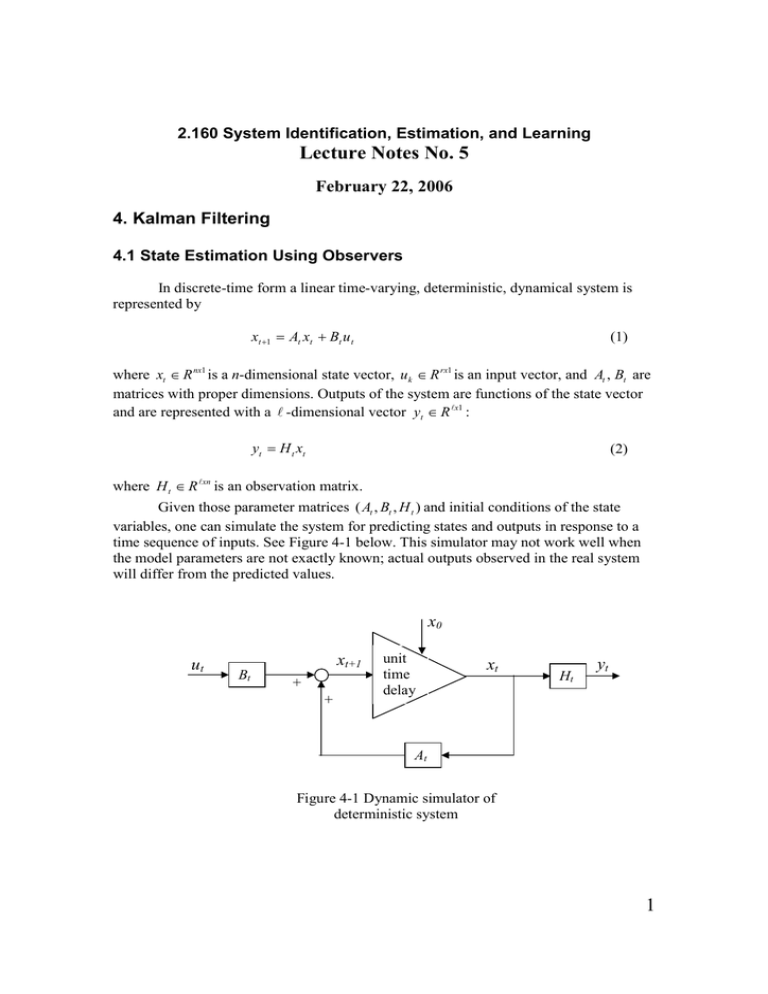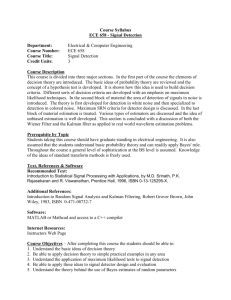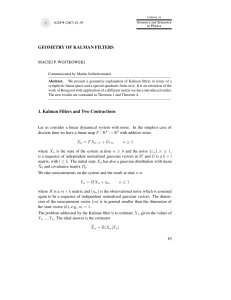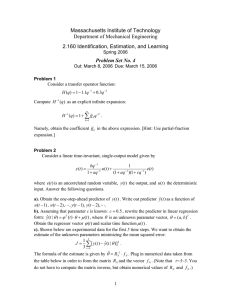Lecture Notes No. 5 February 22, 2006 4. Kalman Filtering
advertisement

2.160 System Identification, Estimation, and Learning Lecture Notes No. 5 February 22, 2006 4. Kalman Filtering 4.1 State Estimation Using Observers In discrete-time form a linear time-varying, deterministic, dynamical system is represented by xt +1 = At xt + Bt u t (1) where xt ∈ R nx1 is a n-dimensional state vector, uk ∈ R rx1 is an input vector, and At , Bt are matrices with proper dimensions. Outputs of the system are functions of the state vector and are represented with a � -dimensional vector yt ∈ R �x1 : yt = H t xt (2) . where H t ∈ R �xn is an observation matrix G iven those parameter matrices ( At , Bt , H t ) and initial conditions of the state variables, one can simulate the system for predicting states and outputs in response to a ee F -1 below. T time seq uence of inputs. S igure 4 his simulator may not workwell when the model parameters are not ex actly k nown;actual outputs observed in the real system will differ from the predicted values. x0 ut Bt xt+1 + + unit time delay xt Ht yt At F igure 4 -1 Dynamic simulator of deterministic system 1 A dynamic state observer is a real-time simulator with a feedbackmechanism for recursively correcting its estimated state based on the actual outputs measured from the ee F -2 below. Note that, unlik real physical system. S igure 4 e a standard feedbackcontrol system, the discrepancy between the predicted outputs yı t and the actual outputs yt from the real system are fed backto the model rather than the real physical system. Using a feedbackgain matrixLt ∈ R nx� , the state observer is given by xıt +1 = At xıt + Bt ut + Lt ( yt − yı t ) yı t = H t xıt (3) T o differentiate the estimated state from the actual state of the physical system, the estimated state residing in the real-time simulator is denoted xıt . With this feedbackthe state of the simulator will follow the actual state of the real system, and thereby estimate the state accurately. If the system is observable, convergence of the estimated state to the actual state can be guaranteed with a proper feedbackgain. In other words, a stable observer can forget its initial conditions;regardless of an initial estimated state xı0 , the observer can produce the correct state as it converges. T his is Luenberger’s S tate Observer for deterministic systems. Real Physical System xt yt + _ G ain Lt ut xıt +1 + Bt + + xıt unit time delay xı0 At Ht yı t Model F igure 4 -2 Luenberger’s state observer for deterministic linear system A special case of the above state observer is estimation of constant parameters θı . ee eq S uation (17) in Chapter 2. Replacing the state transition matrixAt by the nx n identity matrixand setting inputs to zero leads to a recursive parameter estimation formula in (2-17): 2 θı(t) = θı(t − 1) + Κ t ( y (t ) − yı(t ) ) (2-17) T he difference from the previous parameter estimation problem is that in state estimation the state mak es “state transition” as designated by the state transition matrixAt and the uence. Both recursive parameter estimation input matrixBt driven by an input time seq and state estimation, however, are analogous;both based on the Prediction-ErrorCorrection formula. Luenberger’s state observer is strictly for deterministic systems. In actual systems, sensor signals are to some ex tent corrupted with noise, and the state transition of the actual process is to some ex tent disturbed by noise. If stochastic properties of these noise sources are available, state estimation may be performed more effectively than simply using sensor signals as noise-free signals and estimating the sate based on noise-free state transition model. Rudolph Kalman investigated this problem and developed the celebrated Kalman F urprisingly enough, Kalman did it 10 years before Luenberger ilter. S published his state observer paper. T o formulate this stochastic state estimation problem we need to use properties of multivariable random processes, which will be summarized in the following section. 4.2 Multivariate Random Processes Let us revisit S ection 3.2 and consider the ensemble of time profiles again. Each of these waveforms is a realization of random process X(t). (S uch a random waveform can be seen in your oscilloscope, when you increase the gain of a ground signal. T he ensemble of waveforms may be considered as a large collection of the same oscilloscope. If you have hundreds of the same type of oscilloscopes, you have a collection of diverse ground noise waveforms. T hey come from the same ground signal, but the waveforms are all different.) Now that stochastic properties of a single random process have been described with the first and second order densities and auto-correlation functions, let us consider multiple random processes, say X(t), Y(t), and Z(t), and characterize their properties. (In the oscilloscope analogy, you can thinkabout two channels of signals, say channel 1 and channel 2, shown on a single oscilloscope display. If there are a large number of the same type of oscilloscopes displaying both channels, an ensemble of the two random processes can be generated.) A Multivariable random process : A vectorial random proces S tate variables = n-dimential vector Observable outputs with multiple sensors irst-order density fXYZ(x F t,yt,zt) Covariance: Ensemble mean ⎡⎛ X ( t ) − m x (t) ⎞ ⎤ ⎟ ⎥ ⎢⎜ ) C XYZ (t ) = E ⎢⎜ Y (t ) − m Y (t ) ⎟( X (t ) − m x (t ) Y (t ) − mY (t ) Z (t ) − mZ (t ) )⎥ (4 ⎢⎣⎜⎝ Z (t ) − mZ (t) ⎟⎠ ⎥⎦ If mx=my=mz=0 3 [ ] ⎡ E X 2 (t ) E [X (t )Y (t )] E [X (t ) Z (t )]⎤ ⎢ ⎥ C XYZ (t ) = ⎢ E [X (t )Y (t )] E Y 2 (t ) E [Y (t ) Z (t )]⎥ ⎢ E [X (t ) Z (t )] E [Y (t ) Z (t )] E Z 2 (t ) ⎥⎦ ⎣ [ ] [ (5) ] S i S 3 S 2 t S 1 t t X (t ;S1 ) S ix x t t t S 1x t Ensemble of waveforms Y (t;S1 ) t t t1 t2 t1 t Z (t ;S1 ) t2 t1 t t2 t1 t t2 F igure 4 -3 Multivariable random processes S econd-order density: ak T ing two time slices, t1 and t2, as shown in the above figure, the joint probability density is given by: f X 1Y1Z1 X 2Y2 Z 2 ( xt1 , yt1 , z t1 , xt2 , yt2 , z t2 ) If mx=my=mz=0, the covariance is given by ⎡ E [X (t1 ) X (t 2 )] E [X (t1 )Y (t 2 )] E [X (t1 ) Z ( t 2 )]⎤ C XYZ (t1 , t 2 ) = ⎢ E [Y (t1 ) X (t 2 )] E [Y (t1 )Y (t 2 )] E [Y (t1 ) Z (t 2 )]⎥ ⎥ ⎢ ⎢⎣ E [Z (t1 ) X (t 2 )] E [Z (t1 )Y (t 2 )] E [Z (t1 ) Z (t 2 )]⎥⎦ (6) Note that the first order covariance in eq uation (5) can be viewed as a special case of the second order covariance in eq uation (6); t1 = t2 = t . 4 4.3 State-Space Modeling of Random Processes We ex tend the state eq uation given by (1) in the previous section to the one as a multivariable random process. Namely, the state xt ∈ R nx1 is driven not only by the input ut ∈ R rx1 but also by noise, which is a random process. Let wt ∈ R nx1 be a multivariable random process, called “Process Noise”, driving the state through another matrix Gt ∈ R nxn . T he state eq uation is then given by xt+1 = At xt + Bt ut + Gt wt (7) S ee F igure 4 -4 .S ince the process noise is a random process, the state xt driven by wt is a he second term on the right hand side, Bt ut , is a deterministic term. In random process. T the following stochastic state estimation, this deterministic part of inputs is not important, since its influence upon the state xt is completely predictable and hence it can be herefore we often use the following state eq eliminated without loss of generality. T uation: xt+1 = At xt + Gt wt (8) T he outputs of the system are noisy, as long as they are measured with sensors. Let vt ∈ R �x1 be another multivariable random process, called “Measurement Noise”, super-imposed on a deterministic part of the output, the part completely determined by the sate variable xt . y t = H t xt + vt (9) S ee F igure 4 -4 .S ince measurement noise vt is a multivariable random process, the outputs measured with sensor, too, are a multivariable random process. wt Gt ut + Bt vt xt+1 + + unit time delay xt + Ht + yt At F igure 4 -4S tate space representation of linear time varying system with process noise and measurement noise 5 T he stochastic properties of the process noise and measurement noise described above are now characterized as multivariable random processes. It is a common practice that the mean of noise is set to zero since, if the means are non-zero, the origins of the state variables and the outputs can be shifted so that the mean of the noise is zero. E[vt ] = 0 (10) E[wt ] = 0 F rom eq uation (6), the covariance of measurement noise vt ∈ R �x1 is given by T CV (t , s ) = E[vt ⋅ vs ] ∈ R �x� (11) If the noise signals at any two time slices are uncorrelated, T CV (t , s ) = E[vt ⋅ vs ] = 0, ∀t ≠ s (12) the noise is called “White”. (We will discuss why this is called white later in the following chapter.) Note that, if t=s, the above covariance is that of the first order density, i.e. an auto-covariance. T CV (t ) = E[vt ⋅ vt ] (13) T he diagonal elements of this matrixare variances of the individual output signals. If those outputs are coupled through the state variables and the measurement matrixHt, (see uation (9)), it is lik eq ely that the off-diagonal elements of the covariance matrixCv are non-zero. T he process noise can be characterized in the same way. T he covariance matrixis then given by: T CW ( t , s ) = E[ wt ⋅ ws ] ∈ R nxn (14 ) F urthermore, the correlation between the process noise and the measurement noise may ex his can be ist, if both are generated in part by the same disturbance source. T represented with the covariance matrixgiven by: T CWV (t , s ) = E[ wt ⋅ vs ] ∈ R nx� (15) Usually the covariance between the process and measurement noises is zero. 4.4 Framework of the Kalman Filter Consider a dynamical system given by eq uations (8) and (9), 6 xt+1 = At xt + Gt wt (8) yt = H t xt + vt (9) where xt ∈ R nx1 , yt ∈ R �x1 , wt ∈ R nx1 , vt ∈ R �x1 , At , Gt ∈ R n×n , and H t ∈ R �xn . Assume that the process noise wt and the measurement noise vt have zero mean values, E[wt]=0, E[vt]=0. (16) and that they have the following covariance matrices: ⎧0 T CV (t , s ) = E[vt ⋅ vs ] = ⎨ ⎩ Rt ⎧0 T CW (t , s ) = E[ wt ⋅ ws ] = ⎨ ⎩Qt T CWV (t , s ) = E[ wt ⋅ vs ] = 0 ∀t ≠ s (17) ∀t = s ∀t ≠ s (18) ∀t = s ∀t , ∀s (19) where matrixRt is of �x � , and is positive definite, and matrixQt ∈ R nxn is positive semidefinite. Uncorrelated w Process Noise t s time Uncorrelated v Measurement (S ensor) Noise time F igure 4 -5 Noise characteristics Optimal State Estimation Problem Obtain an optimal estimate of state vector xt based on measurements yt, t = 1,2,…t, that minimizes the mean sq uared error: [ ] T J t = E ( xı t − xt ) ( xı t − xt ) (20) 7 subject to the state eq uation (8) and the output eq uation (9) with white, uncorrelated process and measurement noises of zero mean and the covariant matrices given by uations (16) - (18). (Necessary initial conditions are assumed.) eq Rudolf E. Kalman solved this problem around 1960. Kalman F ilter: two major points of his seminal workin 1960. I) If we assume that the optimal filter is linear, then the Kalman filter is the state estimator having the smallest unconditioned error covariance among all linear filters. If we assume that the noise is G aussian, then the Kalman filter is the optimal minimum variance estimator among all linear and non-linear filters. II) 4.5 The Discrete Kalman Filter as a Linear Optimal Filter F igure 4 -6 depicts the outline of the discrete Kalman filter, y1 yt-2 yt-1 All k nowledge up to t-1 yt time Estimation error Estimate output yı t = H t xıt |t −1 S tate Estimate xıt−1 a priori estimate xıt | t −1 Ex pected state transition based on the model Correction to state estimate a posteriori estimate xıt F igure 4 -6 Outline of the Kalman filter algorithm Expected state transition F rom (8), we k now how the previous estimate xıt −1 will mak e a transition xt ⇐ At −1 xt −1 + Gt −1wt −1 ;Let’s write this as xı t t −1 T ransition from estimated state at time t-1, xıt −1 8 xıt t −1 = E[ At −1 xıt −1 + Gt −1wt −1 ] = At −1 xıt −1 + Gt −1E[ wt −1 ] Ex pected state based on xıt −1 Estimated output F orm (9) and (10) yıt = H t xıt t −1 Note E[vt]=0 (21) (22) Correction of the state estimate Assimilating the new measurement yt, we can update the state estimate in proportion to the output estimation error. xıt = xıt t −1 + K t ( yt − H t xıt t −1 ) (23) Eq uation (23) provides a structure of linear filter in recursive form. K t ∈ R n×l is a gain matrixto be optimized so that the mean sq pected value of error) of state uared error (ex estimation may be minimized. A more general form of linear filter is xıt = K t1 xıt t −1 + K t 2 yt (24 ) Both (23) and this form provide the same result. 9





